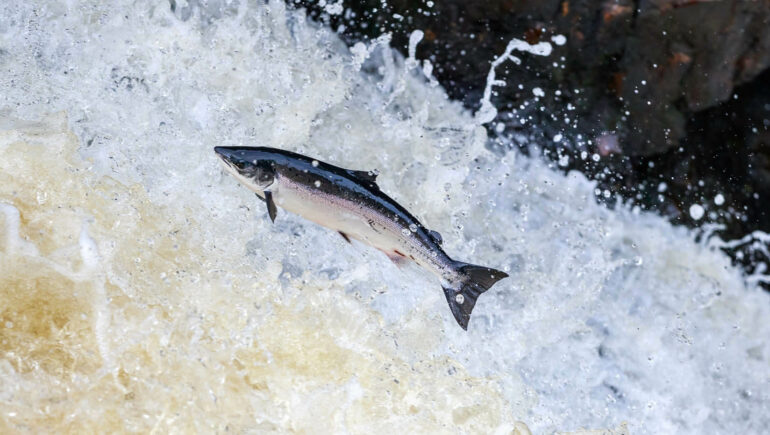Restoration of the critically endangered Atlantic salmon is an important issue in the rivers of Maine. Dams on Maine rivers have long been known to impact fish populations, but a new study led by the University of Maine quantifying the time and energy lost by Atlantic salmon stopped by dams indicate that the structures might have even more of an impact than once thought.
Atlantic salmon return to the rivers of Maine from the ocean every spring to make the long, arduous swim upstream to spawn in freshwater. When the fish are stopped by dams, they are stuck in warmer waters for longer than expected, which can deplete the fat they have stored up to power their journey. The stored energy isn’t just used for migration, but also producing gametes, developing secondary sexual traits and spawning.
“Salmon limit the food they eat in freshwater, so excess energy lost during their migration doesn’t get replaced,” says Sarah Rubenstein, who completed her masters of science in wildlife ecology at the University of Maine in 2021. “However, spawning takes a lot of energy, so the more energy reserves salmon have left after migrating and during spawning, the more likely they will be at successfully reproducing. This is particularly important here in Maine where Atlantic salmon populations have been on the decline since the 1800s.”
For her graduate thesis, Rubenstein led a group of researchers from UMaine and the Maine Department of Marine Resources (DMR) to radio-tag adult Atlantic salmon at the lowermost dams of the Penobscot and Kennebec Rivers in Maine—the Milford and Lockwood dams, respectively—to track their movements upstream. They measured the fishes’ fat stores when the fish were tagged, and then again once they had ascended the dams’ fishways, which are meant to mitigate the impacts of dams by providing a detour route for migrating fish.
The scientists found that the tagged fish were delayed on average between 16 and 23 days at the dams and lost between 11% and 22% of their fat reserves, in large part due to the temperature of the water but also due to the delay in time.
“Delays and poor passage at dams during upstream migrations have been well-documented for Atlantic salmon across their range. We were able to show that these delays have consequences,” says Rubenstein.
One of the results of such dramatic energy loss could be the decline in repeat spawners—adults that survive the spawning process, return to sea and live to migrate another season to spawn—which have nearly been eliminated from Maine’s populations.
Moreover, warming waters as a result of climate change will likely exacerbate the energy depletion. The study suggests that restoration efforts should focus on providing migrating Atlantic salmon with more rapid access to the upstream habitats to get to cooler waters faster.
“We studied the impact of delay at only a single barrier. However, Atlantic salmon often encounter multiple dams or other barriers along their migrations and this can increase the likelihood of a cumulative loss of energy that becomes detrimental,” Rubenstein says. “Improving access to quality habitat benefits migrating fish species and is likely to promote increased spawning, post-spawning survival, and reproductive success in Atlantic salmon.”
The study was published in the Canadian Journal of Fisheries and Aquatic Sciences in September 2022.
More information:
Sarah R. Rubenstein et al, Adult Atlantic salmon (Salmo salar) delayed below dams rapidly deplete energy stores, Canadian Journal of Fisheries and Aquatic Sciences (2022). DOI: 10.1139/cjfas-2022-0008
Provided by
University of Maine
Citation:
Salmon deplete fat stores while stopped at dams, study shows (2023, February 3)



